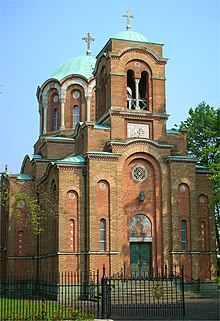Church of the Holy Prince Lazar, Birmingham
| Church of the Holy Prince Lazar | |
|---|---|
 Church of the Holy Prince Lazar | |
| Religion | |
| Affiliation | Serbian Orthodoxy |
| Leadership | Serbian Orthodox Church |
| Location | |
| Location | Bournville, Birmingham, England |
| Architecture | |
| Architect(s) | Dragomir Tadić |
| Style | Serbo-Byzantine |
| Completed | 1968 |
| Materials | Brick, Stone |
| Website | |
| http://lazarica.co.uk/ | |
This article needs additional citations for verification. (January 2017) |

The Church of the Holy Prince Lazar, also known as Lazarica Church, is a Serbian Orthodox church located at Cob Lane in Bournville, Birmingham, England, was built for political refugees from Yugoslavia after World War II, with the support of the exiled Prince Tomislav of Yugoslavia.[1]
Serbs have been associated with Bournville since Dame Elizabeth Cadbury sponsored thirteen Serbian refugee children of World War I.
Built in traditional 14th-century Byzantine form by Yugoslavian architect Dr Dragomir Tadic and Bournville Village Trust, it is a replica of a church in Yugoslavia using stone from the same quarries. Completed in 1968, it is of brick and stone with three sets of bronze doors and a candelabrum from Yugoslavia. It has no seats, which is standard for traditional Orthodox churches. Moreover, the interior has a full scheme of traditional Byzantine decoration. The dome contains the image of the Christ Pantocrator, and the hemi-dome of the apse contains the Virgin. At the bottom of the walls are the warrior saints, above these are patriarchs and priestly saints, and at the top are the apostles and scenes from the 12 Christian feasts. These wall-paintings have not only been executed in a perfect Byzantine style but they also are fresco, i.e. the paint had been applied meticulously to wet walls.
The priest serving today is Nenad Popovic.
The cultural centre is a Grade C locally listed building.
See also
References
- Birmingham Buildings, The Architectural Story of a Midland City, Bryan Little, 1971, ISBN 0-7153-5295-4
- Images of England - Bournville and Weoley Castle, Martin Hampson, 2001, ISBN 0-7524-2443-2
- ^ "Obituary: Prince Tomislav of Yugoslavia". Daily Telegraph.

